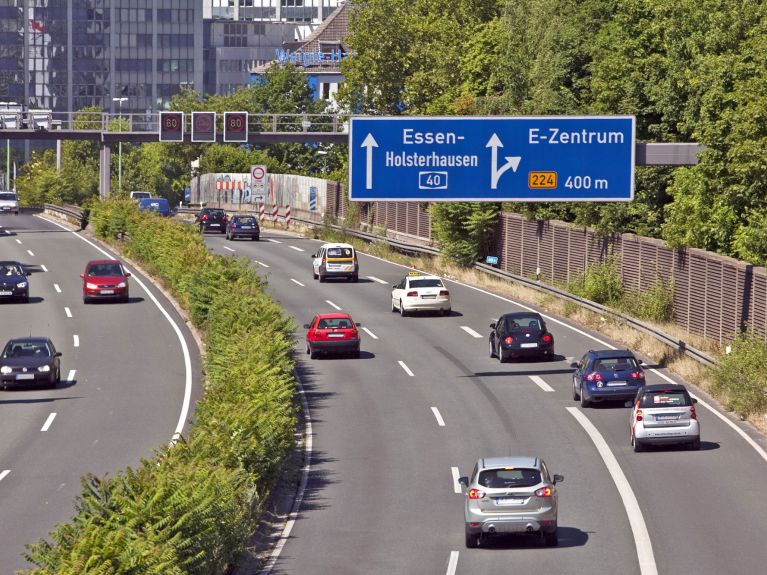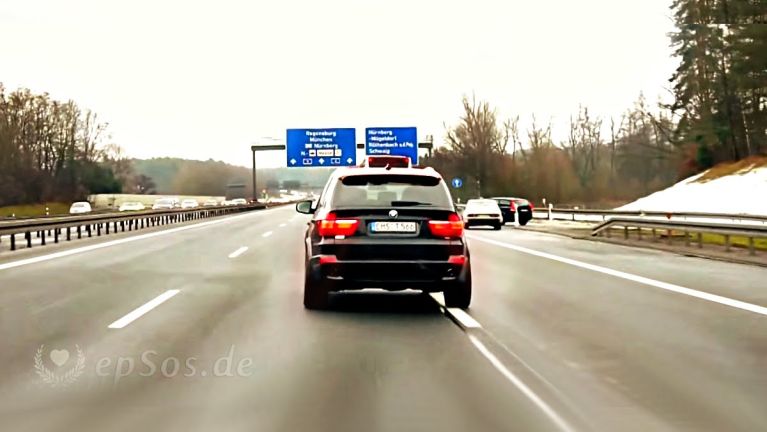Surviving the German Autobahn: Ten guidelines
All you need to know about top speed and speed limits, autobahn laws, dangers and the exit sign.

Around the world, “Autobahn” ranks among the most recognized words of the German language. At its mention, foreigners from all corners of the globe become dreamy-eyed with visions of luxury limousines zooming along flawless multi-lane highways surrounded by lofty mountaintops and dense pine forests. And it gets better, they say: Autobahn is a synonym for “no speed limit!”
But these dreams can turn into nightmares once unsuspecting visitors take on the “Mother of All Highways” unprepared. Before they know it, neophytes will find themselves sandwiched between massive cargo trucks and a slow-moving Dutch trailer, pulled over by police, or harassed by lead-footed wannabe race pilots who claim the left lane as their birthright.
To avoid such rude awakenings, our seasoned test drivers at Young Germany have prepared some insider guidelines for newcomers to the Autobahn. It is, after all, an incredibly well-kept system of toll-free motorways and overall 12,500 kilometers of great fun – if you keep in mind these rules.
1. Know the limit – even on a German Autobahn
We hate to break the cold, hard truth, but contrary to popular belief, there really are–believe it or not–speed limits on the Autobahn. Even though many places allow drivers to pick whatever speed they feel comfortable at, many stretches of blacktop may require you to slow your roll. Construction sites and motorway junctions are classic examples of reduced speed areas. And most of them are swarming with traffic police who unflinchingly hand out tickets, even to aggravated tourists who insist “There are no speed limits on the Autobahn and everybody knows that!” Knowing the limit also implies a realistic assessment of your own driving abilities. Just because your rental car packs enough horse power to go close to 300km/h (that’s almost 200 mph, folks) does not mean you can control this kind of speed. Especially if the speed limit back home is around 120km/h.
Dieses YouTube-Video kann in einem neuen Tab abgespielt werden
YouTube öffnenThird party content
We use YouTube to embed content that may collect data about your activity. Please review the details and accept the service to see this content.
Open consent form2. Survival of the fittest
Here’s the most important rule of driving on the Autobahn: The left lane is for driving fast. Extremely fast. Most newcomers are shocked by the countless luxury limousines and ridiculously fast sports convertibles zipping down the left lane at speeds around 240 km/h, usually while bullying slow movers out of the way with indignant honking and incessant headlight flashing. These people make the two hour drive from Frankfurt to Cologne in 50 minutes. But unless this is also your own style of driving, keep visits to the very left lane brief and stay as far right as you can if you intend to take it easy. It’s a dog-eat-dog world out there!
3. The biggest town in Germany?
Many visitors will be puzzled at the apparently universal presence of that mysterious town “AUSFAHRT,” to which these blue arrow signs that are everywhere are pointing. The frustrating thing is, though, no matter how long you drive – you never seem to get there! “Ausfahrt” is the German word for exit – that’s why.
4. Culinary wasteland
If you want to enjoy good food on the Autobahn, bring your own! Unless you fancy being stuck with soggy gas station sandwiches and whatever scorched mystery sausage is left on the grill that day, shopping for food before your journey is always a good idea. Food at Autobahn rest stops is notoriously expensive, but has improved in recent years.
5. Keep your distance
Tailgating the car in front of you to make it speed up is considered very bad taste. And very dangerous. German traffic law punishes this kind of bullying with a penalty of up to 400€ and by revoking the driver’s license. Traffic authorities suggest a safety distance between cars, which can easily be calculated by dividing the speed at which you are going by two and leaving that amount in meters between yourself and the car in front of you.
Dieses YouTube-Video kann in einem neuen Tab abgespielt werden
YouTube öffnenThird party content
We use YouTube to embed content that may collect data about your activity. Please review the details and accept the service to see this content.
Open consent form6. No sleeping at the wheel
While nobody expects you to risk breakneck speeds on the Autobahn, and it’s perfectly alright to cruise along and enjoy the scenery, speeds lower than 80 km/h are hardly considered up to par, unless there’s construction ahead or you’re towing a massive trailer. There’s a well-known story that goes like this: One day an elderly German citizen decided that it was okay to putter along the Autobahn at 30 km/h. The crew of a traffic helicopter said “No way,” and brought the helicopter overhead to let the driver know that it was time to speed up. Tip: If there are no speed limit signs, it’s recommended to cruise at around 130km/h.
7. Size does matter
Respect the big cargo trucks that are a staple on the Autobahn, even though they are known to be a nuisance by blocking up traffic when passing each other at crawling speeds. Before directing any signals of anger or insult at these drivers, be advised that all of them are connected via FM radio and will gang up on you for some intimidating displays of blaring horns (LOUD!!!) and sandwiching between two trucks if you tick them off. The good news is that trucks are banned from the Autobahn on Sundays and bank holidays.
8. Bring your papers
Toilet papers, that is. Otherwise a quick stop at some forlorn rest area in the hinterlands can turn into an unforeseen emergency, especially if you ended up eating that mystery sausage at the gas station a few kilometers back. In fact, experienced drivers in Germany are known to keep an extra paper roll handy whenever traveling on the Autobahn. In case you ever wondered what people are hiding behind those hand-knitted wool covers, baseball hats and fake dachshunds in the backs of their cars – it’s the emergency stack they wouldn’t leave home without.
9. Stay on the left
Passing other vehicles is only allowed on the left side on German roads. In other countries, speeding by on the right is considered perfectly normal behavior, but it’s an absolute no-no in Germany. Oh, and it’s punishable by law.
10. Do as the Romans do
Generally speaking, newcomers are best advised to stay with traffic and emulate what the locals are doing. If suddenly everyone goes out of their way to follow the speed limit – even those wanna-be formula one pilots in the left lane – you can bet there’s a radar speed check just around the corner. Oh wait… too late! Say cheese. (FLASH!)
Bonus: The best way to enjoy the Autobahn in all of its glory is by waking up early on a Sunday morning before everyone else, only to be greeted by a spectacular sunrise over five lanes of glistening fresh concrete that seem to stretch endlessly into the horizon, wide open for only you and your vehicle. Ah, the moments. Now please excuse us, we have some driving to do…


